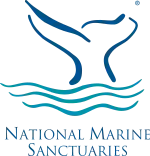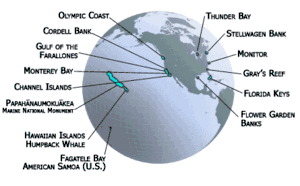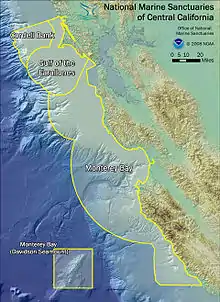United States National Marine Sanctuary
A U.S. National Marine Sanctuary is a zone within United States waters where the marine environment enjoys special protection. The program began in 1972 in response to public concern about the plight of marine ecosystems.
 | |
| Agency overview | |
|---|---|
| Formed | October 23, 1972 |
| Jurisdiction | United States federal government |
| Headquarters | 1305 East-West Highway, Silver Spring, MD 20910 |
| Employees | 350 |
| Annual budget | $50 million (2016)[1] |
| Agency executive |
|
| Parent agency | National Oceanic and Atmospheric Administration |
| Website | www.sanctuaries.noaa.gov |
A U.S. National Marine Sanctuary is a federally designated area within United States waters that protects areas of the marine environment with special conservation, recreational, ecological, historical, cultural, archeological, scientific, educational, or aesthetic qualities. The National Marine Sanctuary System consists of 14 marine protected areas that encompass more than 783,000 square miles (2,030,000 km2). Individual areas range from less than 1 to 583,000 square miles (3 to 1,509,963 km2).[2]
The National Marine Sanctuaries Program (NMSP), a division of the National Oceanic and Atmospheric Administration (NOAA) administers the 14 national marine sanctuaries. The program began after the 1969 Santa Barbara oil spill off the coast of California brought the plight of marine ecosystems to national attention. The United States Congress responded in 1972 with the Marine Protection, Research and Sanctuaries Act which allowed for the creation of marine sanctuaries. The resources protected by U.S. national marine sanctuaries range from coral reef ecosystems in American Samoa, Florida, Hawaii, and Texas, to shipwrecks in the Great Lakes and the Atlantic Ocean.[3] The Papahānaumokuākea Marine National Monument, while not a U.S. national marine sanctuary, is also jointly administered by the NMSP, in conjunction with the U.S. Fish and Wildlife Service and the State of Hawaii.
Scope of protection
Designation as a National Marine Sanctuary does not automatically prohibit fishing and other activities. Recreational and commercial fishing is allowed in some sanctuaries. It is possible to restrict consumptive or destructive activities through the initial designation process and NMSP actions. There are restrictions in some sanctuaries that are enforced by other governing agencies. For example, current regulations restricting fishing in Stellwagen Bank were not issued by the NMSP, but rather by NOAA Fisheries and the New England Fishery Management Council, which have jurisdiction in federal waters off the New England coast generally.[4] The private non-profit Marine Conservation Institute has compiled fact sheets for each sanctuary listing activities which are directly regulated by the NMSP.[5]
List of U.S. National Marine Sanctuaries


- Channel Islands National Marine Sanctuary (Pacific)
- Cordell Bank National Marine Sanctuary (Pacific)
- National Marine Sanctuary of American Samoa (formerly Fagatele Bay) (Pacific)
- Florida Keys National Marine Sanctuary (Atlantic, Gulf of Mexico)
- Flower Garden Banks National Marine Sanctuary (Gulf of Mexico)
- Gray's Reef National Marine Sanctuary (Atlantic)
- Greater Farallones National Marine Sanctuary (formerly Gulf of the Farallones) (Pacific)
- Hawaiian Islands Humpback Whale National Marine Sanctuary (Pacific)
- Mallows Bay National Marine Sanctuary (Atlantic)
- Monitor National Marine Sanctuary (Atlantic)
- Monterey Bay National Marine Sanctuary (Pacific)
- Olympic Coast National Marine Sanctuary (Pacific)
- Papahānaumokuākea Marine National Monument (Pacific)
- Stellwagen Bank National Marine Sanctuary (Atlantic)
- Thunder Bay National Marine Sanctuary (Great Lakes)
Proposed
- Lake Michigan National Marine Sanctuary (Great Lakes)[6]
Notes
- NOAA Budget Summary (PDF). United States Department of Commerce. Retrieved August 29, 2016.
- National Marine Sanctuary Frequently Asked Questions
- Casserley, TR. "Torrid Seas to Icebound Lakes: Shipwreck Investigations within NOAA's National Marine Sanctuaries". In: Pollock NW, ed. Diving for Science 2009. Proceedings of the American Academy of Underwater Sciences 28th Symposium. Dauphin Island, AL: AAUS; 2009. Retrieved March 6, 2013.
- "About: FAQ: Stellwagen Bank National Marine Sanctuary". Retrieved September 30, 2014.
- National Marine Sanctuaries » Marine Conservation Institute
- Briscoe, Tony. "Underwater sanctuary plan aims to preserve Lake Michigan shipwrecks off Wisconsin". chicagotribune.com. Retrieved September 17, 2017.